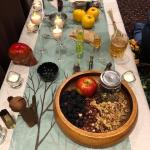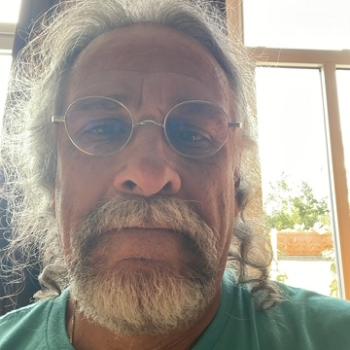The Second Battle of Maige Tuired(CMT2) says:
“There were four cities in which they were learning lore and science and diabolic arts, to wit Falias and Gorias, Murias and Findias.
Out of Falias was brought the Stone of Fál, which was in Tara. It used to roar under every king that would take the realm of Ireland.
Out of Gorias was brought the Spear that Lugh had. No battle was ever won against it or him who held it in his hand.
Out of Findias was brought the Sword of Nuada. When it was drawn from its deadly sheath, no one ever escaped from it, and it was irresistible.
Out of Murias was brought the Dagdae’s Cauldron. No company ever went from it unthankful.Four wizards there were in those four cities. Mór-fesae was in Falias: Esras was in Gorias: Uscias was in Findias: Semias was in Murias. Those are the four poets of whom the Tuatha Dé learnt lore and science(Stokes).”
In the Yellow Book of Lecan, the text called “The Four Jewels of the Tuatha Dé Danann” describes the four treasures in greater detail than the CMT2. It describes the four treasures, the four isle-cities of learning, and the four druids, the antediluvians, who taught the gods their skills and magic.
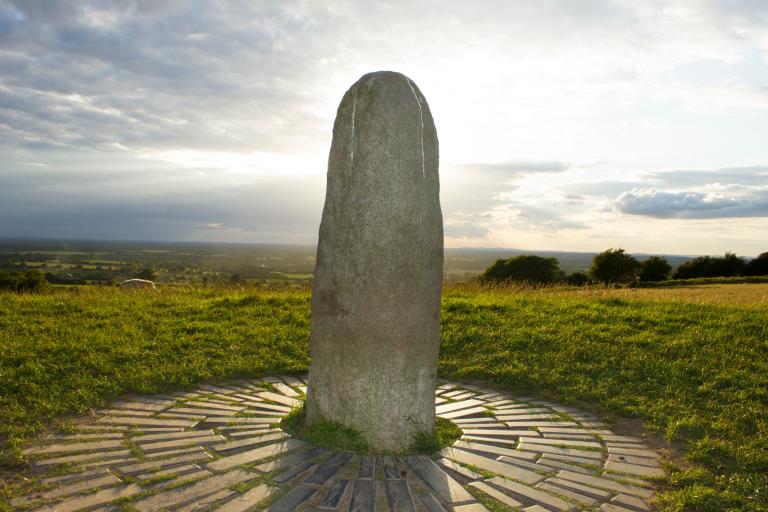
The first island or city is Failias, from which comes the stone of sovereignty placed at Tara, and upon which the coronation of righteous kings was made. It was named the Lia Fál, and it is said that the stone no longer cries out since the birth or baptism of the son of the Christian god, because a spirit was expelled from it. I personally think it was a symbolic cry that came from the people who elected the rightful king. The druid in Failias was Morfessa, The poem from the above text says he was a poet.
The second is Gorias, from which came Nuada’s sword, from which no one could run from after they were wounded by it. When drawn from its scabbard, it attracted those whom it was drawn against in a way that he could not resist its bearer. The wizard in this city was Esrus, described as noble and of keen desires, a phrase describing an intense demonstration of desires.
The third isle-city is Findias, from which the spear of Lug, the Sleg Lug, came. The druid in this city is described as Uscias, the fair seer. No battle was ever maintained against the bearer of the spear. Lug, due to having the spear, might have gained his name Lugh Lámhfada, Lugh of the Longarm. But he may have also gained this name from the use of the sling against Balor, or his other spear the Gae Assail.
The fourth was Murias, from which came the Dagda’s Cauldron, the Un-dry because it is never dry of nourishment. None walk away from it unsatisfied. The wizard in this city was called Semias, and he is described as ever-fierce and his city was called the fortress of pinnacles.
Four presents (were fetched) with them hither,
By the nobles of the Tuatha De Danann:
A sword, a stone, a caldron of worth,
(And) a spear for the death of great champions.From Failias (came) hither the Lia Fail,
Which shouted under the kings of Ireland.
The sword in the hand of the nimble Lug
From Gorias (it was procured), -— a choice of vast riches.From far-away Findias over the sea
Was brought the deadly spear of Nuada.
From Murias (was conveyed) a huge and mighty treasure,
The cauldron of the Dagda of lofty deeds.(Hull)
The four treasures are not analogous with the suits of the Tarot or the Hermetic magical tools of stone or pentacle, chalice or cauldron, athame or sword, wand or spear. These four Wicco-hermetic tools are associated with the four elements, which are in turn associated with the four directions. While the four treasures and these tools are similar, the Lia Fál, or sovereignty stone’s place is in the center, one of the five directions in Celtic lore, rather than in the north as hermetic magic prescribes, which is one of the five directions discussed below. So there is a conflict between existing Celtic tradition and neopagan Wiccan tradition. The Lia Fál is not associated with Earth, but instead, with Center, where Wiccan practice places spirit, and where we recognize the pinnacle of spirit, Sovereignty and the deserved right to rule through virtue and truth.
Instead, we can just focus on these as the main talismans of our gods. When Norse pagans revere Mjolnir, Celtic pagans can revere these and other talismans, such as Dagda’s Club.
Other Talismans
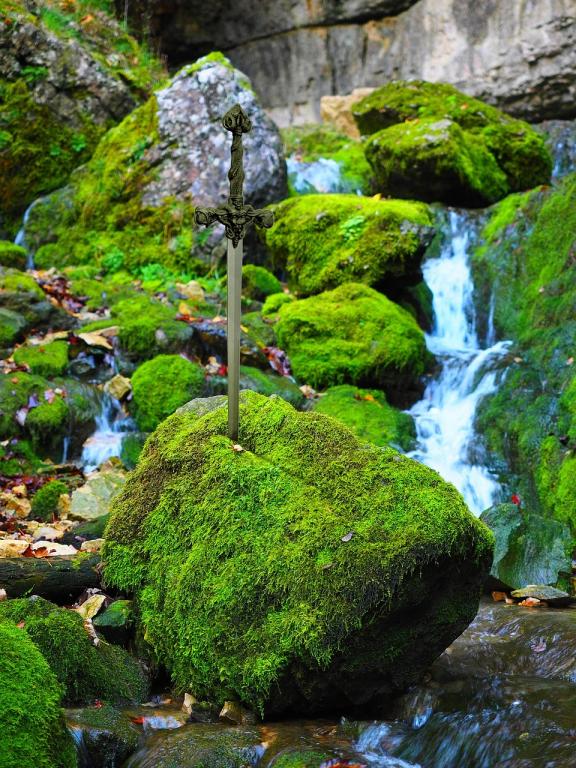
Caladbolg
Probably originally a spear(Ó hÓgáin 217), because bolgos means lightning, this sword when swung could cleave the land, hills, and earth. Its arc through the air would make a rainbow as it expanded up to the firmament(O’Curry 320). It was wielded by Fergus from the Tain, of which there are two, who both wielded it.
Then his sword was given to Fergus and Ailill said: ‘Take your sword. Though you may smite Ireland, a great warrior of her sons will fight at Gáirech … For honour’s sake do not wreak your fierce anger on us in the presence of the chariot-fighters of Ulster…’ ‘Welcome, O hard blade, the sword of Leite! … My sword shall not inflict slaughter on you. I am a proud leader as I stand before the men of Ireland.’ – Táin bó cúailnge, C.E.L.T.
Dagda’s Club
Dagda’s club was won when he tricked the three men who say they are ‘three sons of one mother and one father’. He met them on the road when Cermait died in a battle with Lug. He was traveling to find a way to revive his son. He found the three men and asked them about their three treasures, and when they mentioned the club’s rough end causing death and the smooth end causing them to come back to life, he asked them to hand it to him. When they did, he slew them with the rough end and revived Cermait, who begged the Dagda to bring them back to life. Once he did, he tricked them into giving him the club ‘provided he slay his enemies and revive his friends’ effectively allowing him to use it forever, since you are always making new friends and enemies(Bergin).
Life and Death are just other forms of Samos and Giamos, and the alternation between life and death is a power which the Dagda wields through his striking weapon, just as he influences Summer and Winter with his harp.
Dagda’s Harp
Both his harp and his harper, Uaine, controls the seasons. In the CMT2 it is stolen by Fomorians and Dagda says a charm which causes it to fly across the room and kill a nine of them. Its names are Four Angled Music and Oak of the Two Blossoms, and it played the Three Strains of Sorrow, Laughter, and Sleep.
Dian Cecht’s Well
Named Slaine, into this well is where the Tuatha Dé cast their dead during the battle of Maige Tuired(Moytura) to be revived and ready again for battle. Herbs were put in, Dian Cecht with his two Sons and his daughter Airmed together, they charmed it into a well of revival.
They would cast their mortally-wounded men into it as they were struck down, and they were alive when they came out. Their mortally-wounded were healed through the power of the incantation made by the four physicians who were around the well. – CMT2 (Gray)
Manannán’s Treasures
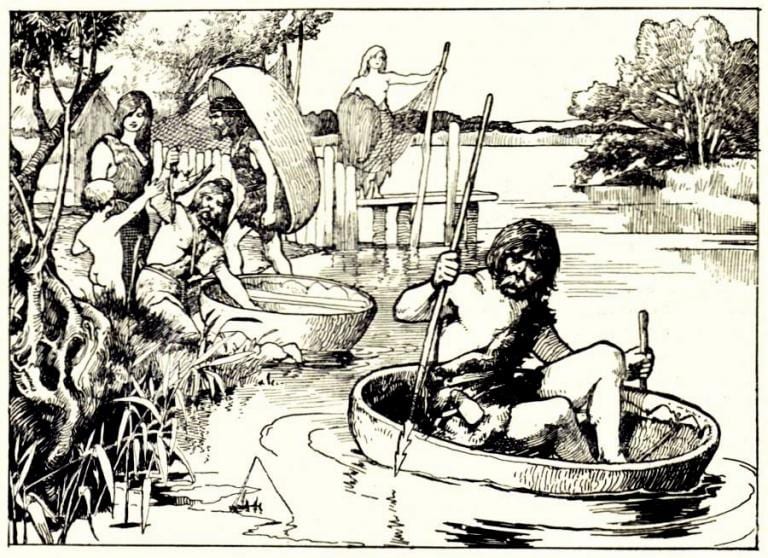
Fragarach, the Answerer was Manannán’s sword which he has to Lugh who in turn gave it to Cu Chulainn. No one could tell a lie or move when it was held against their neck, thus its name. It was also called the Retaliator. His horse was called Aonbharr meaning “One Mane”, though MacKillop’s dictionary suggests “Unique Supremacy” as a meaning for the name(MacKillop). Another interpretation of his name is ‘water-foam’ (Ó hÓgáin 330). Aonbharr or Enbar in Old Irish could ride oversea as if it was land. Wavesweeper or Sguaba Tuinne meaning ‘Sweeper of the Waves’ was his coracle. A coracle is a small fishing boat made out of sticks and bovine hide fashioned into a semi-sphere which goes convex side down into the water and are common to fishing communities from Ireland to India. Wavesweeper is said to grow and shrink to accommodate any load and to go anywhere in any direction at the thought of its captain. Crann Buidhe was his spear. Manannán’s magical swine are what the gods feast on, each day they are slaughtered for the feast and upon the next morning they are again alive(Green, 170). Manannán’s cloak, named Féth Fiadha, meaning ‘the art of semblance’, causes forgetfulness when it is shaken between the bearer and the target(Ó hÓgáin 330). Lastly, his crane bag can fit any number of items, including his house, knife, shirt, and shield.
Nectan’s Well
And when the sun sets dimmed in eve, and purple fills the air,
I think the sacred hazel-tree is dropping berries there,
From starry fruitage, waved aloft where Connla’s Well o’erflows;
For sure, the immortal waters run through every wind that blows. – The Nuts of Knowledge, George William Russell(Yeats)
Nectan’s Well was a well belonging to Nuadu Necht(Ó hÓgáin 386). It was located in the Sidh dwelling of Nechtan and was said to be the source of the river Boyne. The area at the top of the Boyne now is called Segais, another name for the well. Sometimes called or conflated with Connla’s well, which is also the source of the River Síonnon. There are five streams that come from the well in which sacred salmon swim upstream toward the well-pool itself, where nine hazel trees grow. These hazel trees drop nuts into the well which contain the wisdom of the secret workings of the universe. The Salmon eat these and sometimes the salmon are consumed and a person is transformed and reborn.
Some modern pagans, including myself, see these five streams as an allegory for the five senses which flow outward and not inward. One could say that outward flowing senses inform the world by their sensing just as much as they are informed by the salmon of wisdom that swims back up our senses to be joined with our nuts of memory and understanding in order to be precipitated into new wisdom and realizations of knowledge.
Boann, the wife of Elcmar/Nechtan/Nuada, approached the well against taboo and encircled it three times counter-clockwise. It rose up and destroyed her flooding the Boyne valley into the river Boyne. Only the King and his cupbearers were allowed to approach it and only in certain ways(Meyer 240). But Queen Bofind(An Boanne), wanted to taste its waters to test its powers.
Hither came on a day white Boand(her noble pride uplifted her),
55] to the well, without being thirsty
to make trial of its power.
As thrice she walked round
about the well heedlessly,
three waves burst from it,
60] whence came the death of Boand.
They came each wave of them against a limb,
they disfigured the soft-blooming woman;
a wave against her foot, a wave against her perfect eye,
the third wave shatters one hand.
65] She rushed to the sea (it was better for her)
to escape her blemish,
so that none might see her mutilation;
on herself fell her reproach.Every way the woman went
70] the cold white water followed
from the Sid to the sea (not weak it was),
so that thence it is called Boand(Loughlin).
Orna, the sword of Tethra
Orna was found by Ogma after Tethra was slain. Oghma unsheathed Tethra’s sword and cleaned it, and it recounted its deeds to him, and that is why the warriors of Ireland used to always clean their swords after unsheathing them.
Sources:
need: gray, celt-tain, russell
Bergin, Osborn. “How the Dagda Got His Magic Staff.” AKA Mary Jones, Mary Jones, www.maryjones.us/ctexts/dagda.html.
Green, Miranda. Animals in Celtic Life and Myth. Taylor and Francis, 2002.
HÓgáin Dáithí Ó. The Lore of Ireland: an Encyclopaedia of Myth, Legend and Romance. Boydell Press, 2006.
Hull, Vernam. “The Four Jewels of the Tuatha Dé Danann.” Studia Celtica: The Bulletin of the Board of Celtic Studies • CODECS: Online Database and e-Resources for Celtic Studies, www.vanhamel.nl/codecs/The_four_jewels_of_the_Tuatha_D%C3%A9_Danann.
Loughlin, Annie. “Tag Archives: Boann.” Tairis Tales, heelancoo.wordpress.com/tag/boann/.
Mackillop, James. Dictionary of Celtic Mythology. Oxford University Press, 2017.
O’Curry, Eugene. Manners and Customs of the Ancient Irish. Vol. 2.
Stokes, Whitley. “The Second Battle of Moytura.” The Treaty of Limerick, 1691, 2004, celt.ucc.ie//published/T300011.html.
Gray, Elizabeth. “CATH MAIGE TUIRED.” Legends of the Gods, The Egyptian Texts: Introduction: Summary: I. The Legend of the God Neb-Er-Tcher, and the History of Creation, www.sacred-texts.com/neu/cmt/cmteng.htm.
Unknown. “Táin Bó Cúalnge Recension 1.” The Treaty of Limerick, 1691, celt.ucc.ie//published/T301012/text001.html.
Yeats, William Butler. The Collected Works of W.B. Yeats Volume IX: Early Art: Uncollected Articles. IX.



